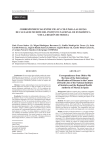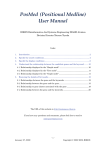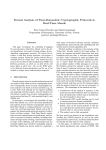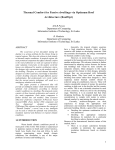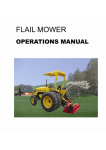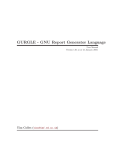Download From troubleshooting to process design: closing the manufacturing
Transcript
From troubleshooting to process design: closing the manufacturing loop C. J. Price, I. S. Pegler, M. B. Ratcliffe, A. McManus Department of Computer Science University of Wales, Aberystwyth Ceredigion, SY23 3DB United Kingdom email: [email protected] Abstract This paper describes the dual use of a case base for diagnosis and for improving the design of a manufacturing process. In the short term, the case base is used to provide past experience in dealing with similar problems during the manufacture of aluminum components. In the longer term, it is used to feed that experience into the design of the manufacturing process for new components. This is achieved by having a case base of previous manufacturing process problems and solutions. For diagnosis, case base matching is done in a fairly straightforward manner. In order to use the cases in design analysis, the case information about process type and problems with a particular process is fed into a process failure mode and effects analysis (FMEA), and provides details of possible problems and their likelihood. This paper appears in the Proceedings of the 2nd International Conference on Case-based Reasoning, Providence, Rhode Island, July 1997. 1. Introduction The use of cases for troubleshooting problems has been one of the success stories of casebased reasoning (CBR), for example [1,2]. This paper describes a case-based assistant for troubleshooting process problems in an aluminum foundry. This work extends the use of CBR for troubleshooting in two significant ways. Firstly, the storing of cases for use in troubleshooting is done implicitly, rather than by an explicit software maintenance action as is usually the case. The reason why this is practical are discussed. Secondly, and more significantly, the cases are used as a way of closing the loop back to design, in an attempt to improve the manufacturing process by reducing the incidence of similar problems in the future. 2. Troubleshooting the foundry with cases A brief description of the pressure die casting process The parts produced by aluminium die-casters are typically finished products. The process of casting the metal is only one of a long list of operations such as clipping, milling, drilling, powder coating, inspection, storage, transportation. Each of these processes is subject to different kinds of failures. The machines used to cast the metal vary in the way they operate. Most machines inject the metal from the side, others from the top. In addition, a vacuum system can be used to drain air from the cavity prior to casting, in order to lessen the effect of air pockets in the casting. Larger machines would be used to cast heavier or more complex parts. The characteristics of the die can also vary, from a simple die of two halves, to a more intricate system with sliders and cores that allow more complex shapes to be cast. Some dies contain multiple impressions of the same part, so that several can be made during one casting cycle. Although the kinds of problems that occur in the die casting process are similar from one foundry to another, the methods used to tackle the problems can be foundry-specific. Because there are different approaches to casting, building a general rule-based troubleshooting system for foundries would be difficult. Troubleshooting requires detailed knowledge of design constraints, customer requirements and the manufacturing process as implemented at the particular foundry. This means that troubleshooting information is often foundry specific, and best expressed as cases. Recording foundry problems The foundry process troubleshooting system was based on an existing paper-based process concern report (PCR) quality control system, where process problems were recorded on paper and tracked until they were solved. In the worst cases, a truckload of aluminum components might be returned from a customer because of some problem such as bad surface finish. Figure 1: Problem specification in troubleshooting system The foundry staff would need to: • record the return of stock • check the quality of further components of the same type made since the delivery • identify whether the problem was still occurring and fix it • decide what could be done with the returned stock • plan what to do to avoid repetition of the problem in future The computerised version of the PCR system records problems in a database, and has links to other foundry databases in order to make entry of information as painless as possible, e.g. by entering a component name, the PCR system pulls in customer details. The problem is described by selecting the process name from a list of processes, and then selecting a problem type from a list of possible problems with that process. In addition, free text may also be used to describe the problem. An example of a problem specification is given in figure 1. Matching past problems When the basic problem description has been entered, the user can choose to perform case based matching against previous similar problems. Cases in the PCR system are flat database records. Case matching is done by nearest neighbour, and produces a list of possibly relevant cases by a weighted match on: • type of the process in which the problem occurred • specific problem with the process • component category • component attributes • recentness of past problem A list of matches like the one shown in figure 2 is produced. The user can look through this list and examine the detailed record of each past case, using their judgement to select the most appropriate of the matches. The component category matching is based on a component hierarchy, and is used to order the cases in such a way that the most likely cases will be those as close as possible in the hierarchy to the problem. Classifying the components manufactured at the foundries involved investigation of the quality demands required of different types of component. Different categories with identical quality demands were merged. The process of building the classification tree was an iterative process requiring a great deal of consultation with quality managers. When a good match with a past case is found, details of the actions taken last time can be imported to the present case, providing information on matters such as the appropriate team of people to deal with the problem, the actions needed to solve the problem, and the most efficient way to handle the faulty components already made. As well as providing painless entry of information, the foundry staff have been encouraged to use the PCR system by provision of facilities such as automated faxing of problem report acknowledgements to customers, and problem tracking facilities for quality managers to monitor the progress of solutions to problems. Figure 2: Matching problem to past cases The PCR system has been installed at three aluminum foundries which run similar computing facilities. Each foundry presently has a three figure number of cases recorded, and uses the system to record, track and help fix all problems that occur. One of the notable features of the PCR system is that no outside support for case base maintenance is needed. All problems are eventually fixed, and when they are, the foundry quality manager “closes” the problem report. The act of closing a problem report essentially validates the case associated with that problem report, saying that an acceptable solution has been found. Only closed (and therefore validated) reports are matched in case-based matching. The foundry quality managers are validating the casebase while carrying out their normal function. Structure of case The structure of the entities used in the case base has been defined using the EXPRESS information modelling language [3]. The following is a simplification of the EXPRESS description for a case. (* definition of abstract PCR *) ENTITY QPAC_PCR date_raised: date; customer: business; customer_contact: person; foundry_contact: foundry_person; die_number: die_num_type; part_number: part_num_type; process_area: process_type; problem: problem_type; severity: severity_type; reaction: reaction_type; occurrence: percentage; -- percentage of parts affected quantity: whole_number; -- number of parts affected description: strings; actions: LIST [1:?] OF action; WHERE problem_ok: applicable(problem,process_area); END_ENTITY; -- end of top level PCR entity (* entity to define a simple action *) ENTITY action; action_by: foundry_person; action_taken: action_taken_type; action_status: action_status_type; END_ENTITY; action_status: (for_information_only, further_action_required, success, failure); The cases are stored using a DBASE3 database, and case retrieval is done by database access and the weighted match described earlier. 3. Feeding cases into process FMEA One of the tasks often carried out when designing the manufacture of a new aluminum component is a process Failure Mode and Effects Analysis (FMEA) [4]. Process FMEAs are often carried out by design engineers rather than staff in day to day contact with what happens on the foundry floor. In theory, they are supposed to be a live document, reflecting the latest experience of problems on the factory floor. In practice, that is seldom the case. The Process Concern Report case base contains a history of process problems that can be used to feed practical experience into the process FMEA exercise. In this way, the case based experience that has been built up can help to eradicate those process problems during the design stage of a new component. The key to the use of the case base in this way is a process flowchart system that enables an engineer to describe the processes that are carried out during manufacturing. This is done by selecting process names from a drop down list. This list contains the same processes as are used in the troubleshooting system. By enumerating all of the processes used to manufacture the part, a list of process/failure combinations can be generated for use in FMEA (see figure3). The validated case base can be used to supply real data on the problems that can occur with each process. The severity and frequency information about related past cases can be used to attach significance values to each possible problem, highlighting for the engineers the most important problems to tackle. The case base also includes the foundry staff’s best advice on precautionary steps for avoiding such problems in the long run, feeding that experience into the design process. Figure 3: Process flowchart for making a new component Again, the relevance of such past cases is decided not just by matching similar processes, but by a more complex match including component attributes and similarity in the component hierarchy. Process FMEAs are intended to be ‘live’ documents, i.e. continually referenced and updated. In practice these documents are produced to satisfy customer requirements and are rarely utilised to their full potential. Typically they are referenced as a last resort when troubleshooting. Using case-based reasoning to integrate FMEA generation with problem logging, troubleshooting and quality-related tasks maximises the potential for the re-use of design and troubleshooting knowledge within the foundry. 4. Summary Figure 4 illustrates the central role that the PCR case base plays in troubleshooting and in design. Case-based reasoning provides the cornerstone for allowing troubleshooting knowledge to be built up and re-used for quality-related procedures. It provides excellent data for creating a realistic process FMEA report, and even beyond that, for deciding on inspection and control checks in the foundry itself. Internal PCR Troubleshooting External PCR Die / Customer database PCR case base FMEA Control Plan Instruction Sheets SPC / Capability database AQP Project Management Gauge Plan Activities Listing Timing Plans Figure 4: Overall troubleshooting/design perspective The largest of the foundries where the case based system described in this paper has been implemented has less than 400 employees. Even in companies of this size, CBR provides a valuable repository of past decisions, and feeding that experience into future designs is proving valuable. The potential for this kind of system should be even greater in large companies where knowledge is more widely diffused through the organisation. Acknowledgements This work has been carried out on the UK EPSRC funded project GR/K/81829, with the cooperation of Kaye (Presteigne) Ltd, Morris Ashby Ltd and Burdon and Miles Ltd. Building the cases was possible due to the assistance of the three Foundry Quality Managers, Stuart Lewis, Ken Hawkes and Barry Clayton. References [1] T. L. Acorn and S. H. Walden, SMART: Support Management Automated Reasoning Technology for Compaq Customer Service, in Innovative Applications of Artificial Intelligence 4, pp3-18, eds: A. C. Scott and P. Klahr, AAAI Press, 1992. [2] I. Dattani, R. V. Magaldi, M. A. Bramer, A Review and Evaluation of the Application of Case-based Reasoning (CBR) Technology in Aircraft Maintenance, Applications and Innovations in Expert Systems IV, pp189-203, SGES Publications, 1996. [3] D. A. Schenck and P. R. Wilson, Information Modeling the EXPRESS Way, Oxford University Press 1994. ISBN 0-19-508714-3. [4] Failure Mode and Effects Analysis Handbook, Ford Motor Company Ltd, 1995.







